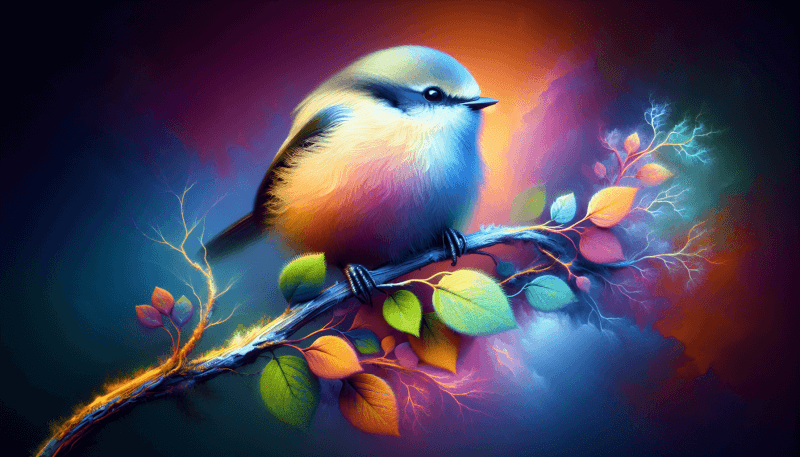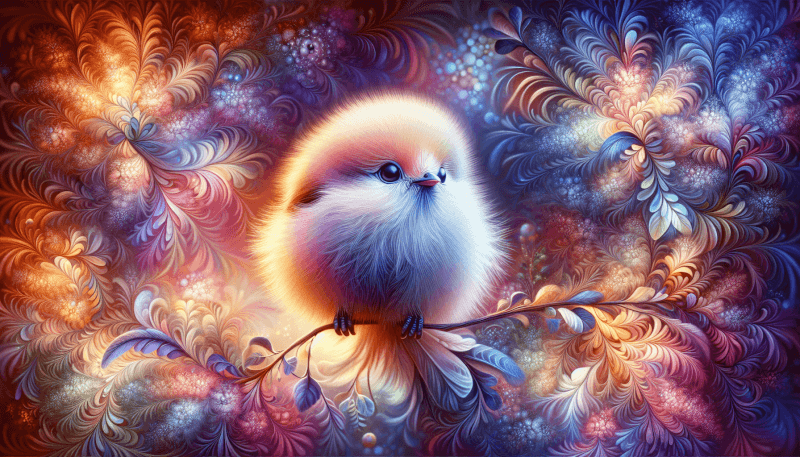Imagine a world where birds are not only majestic and graceful but also irresistibly fluffy. In this enchanting article, we will take you on a journey to discover the existence of a unique and captivating creature – the fluffy bird species. With their feathery plumage that resembles cotton candy and their playful nature, these birds are sure to capture the hearts of bird lovers everywhere. Get ready to be delighted as we explore the charm and wonder of these adorable avian creatures.
Overview of Fluffy Bird Species
Fluffy bird species are a diverse group of avian creatures known for their soft and fluffy feathers, adorable appearance, and enchanting behaviors. These birds captivate the hearts of bird enthusiasts and nature lovers alike. In this comprehensive article, we will delve into the fascinating world of fluffy bird species, exploring their appearance, habitat, behavior, and more. So grab your binoculars and get ready to embark on a journey into the enchanting realm of fluffy birds!
Appearance
Fluffy birds are characterized by their soft, downy feathers that give them a cuddly and adorable appearance. These feathers are often puffy, making the birds look larger and more rounded than they actually are. Their feathers come in a variety of colors, ranging from vibrant shades of red and yellow to more muted hues of gray and brown. Many fluffy bird species also exhibit distinctive markings, such as spots, stripes, or patterns, which add to their charm.
Habitat
Fluffy birds can be found in a wide range of habitats across the globe. Some species prefer lush forests with dense vegetation, where they can camouflage themselves among the trees and foliage. Others thrive in open grasslands or wetlands, where they can find an abundance of food and nesting sites. From tropical rainforests to arid deserts, fluffy bird species have adapted to various environments and can be found in almost every corner of the world.

Behavior
Fluffy birds are known for their captivating behaviors, which make them a delight to observe in the wild. Many species are highly vocal, bursting into a chorus of songs and calls that fill the air with their melodious tunes. These vocalizations serve various purposes, such as attracting mates, defending territories, or communicating with their flock members. Fluffy birds are also skilled nest builders, creating intricate structures with twigs and leaves to protect their eggs and raise their young. Some species even perform elaborate courtship displays, dancing or puffing up their feathers to impress potential mates.
Popular Fluffy Bird Species
Within the realm of fluffy birds, there are several species that have captured the attention and admiration of bird enthusiasts worldwide. Let’s take a closer look at three of the most popular fluffy bird species: the robin, the owl, and the dove.
Robin
The robin is a small, songbird known for its vibrant red breast and endearing appearance. It can be found in gardens, parks, and woodlands throughout Europe, Asia, and North America. Robins are highly territorial and can often be seen fiercely defending their feeding areas against intruders. Their sweet and melodic songs are a common sound in gardens during the springtime, and they are a beloved symbol of the holiday season in many cultures.
Owl
Owls are nocturnal birds of prey with a majestic and mysterious aura. Their fluffy feathers provide insulation, allowing them to silently glide through the night sky in search of prey. With their large, round eyes and ability to rotate their heads nearly 360 degrees, they are well-equipped for their nighttime hunting activities. Owls are revered in many cultures and are often associated with wisdom and knowledge.
Dove
Doves are gentle and peaceful birds that are often considered a symbol of love and peace. Their soft, fluffy feathers come in a variety of colors, including white, gray, and brown. Doves are known for their melodic cooing sounds, which can create a soothing atmosphere. These birds can form strong pair bonds and are often seen nesting in trees or on ledges. Doves have a global presence and can be found in both urban and rural environments.
Characteristics of Fluffy Birds
Fluffy birds share several common characteristics that contribute to their unique charm and appeal. These include their feathers, size, and coloration.
Feathers
Fluffy birds have a special type of feather called down feathers, which are soft and provide excellent insulation. These feathers help to regulate the birds’ body temperature, keeping them warm in colder climates and protecting them from extreme weather conditions. The fluffy appearance of these feathers also adds to the birds’ adorable charm.
Size
Fluffy bird species vary greatly in size, ranging from small songbirds like the robin to larger birds of prey like the owl. The size of a bird can impact its behavior, habitat preferences, and feeding habits. Some smaller fluffy birds are agile fliers, darting in and out of trees, while larger species may have a more majestic and powerful flight.
Coloration
Coloration is another distinguishing feature among fluffy bird species. Some birds, like the robin, display vibrant and eye-catching colors, which are often more pronounced in males during the breeding season. Others, such as owls and doves, have more subtle coloration, often blending in with their surroundings for camouflage. These variations in coloration serve different purposes, such as attracting mates, camouflage, or warning predators.

Fluffy Birds as Pets
With their soft feathers and enchanting behaviors, it’s no wonder that some people may be tempted to keep fluffy birds as pets. However, it’s important to carefully consider the suitability of these birds as pets and ensure their welfare.
Suitability as Pets
While some species of fluffy birds can be kept as pets, it’s crucial to research and understand the specific needs and requirements of the species you are interested in. Fluffy bird species have diverse dietary, environmental, and social needs that must be met in order for them to thrive. Some species may require large and spacious enclosures, regular exercise, and mental stimulation to keep them healthy and happy.
Care and Maintenance
Providing proper care for a fluffy bird can be a rewarding experience but also requires commitment and dedication. Regular veterinary check-ups, a balanced diet, and a clean living environment are essential for their well-being. Fluffy birds may also benefit from social interaction and mental stimulation, such as engaging toys and puzzles, to prevent boredom and promote their natural behaviors.
Interaction and Bonding
Fluffy birds can form strong bonds with their human caretakers. However, it’s important to approach interactions with these birds with patience and respect. Building trust takes time, and it’s crucial to provide positive reinforcement and avoid forcing interactions. With proper socialization and training, fluffy birds can become affectionate companions, delighting their owners with their endearing behaviors and cheerful personalities.
Endangered Fluffy Bird Species
Unfortunately, many fluffy bird species are facing the threat of extinction due to various factors such as habitat loss, climate change, and poaching. Conservation efforts are essential to protect these magnificent creatures and ensure their survival for future generations.
Conservation Efforts
Numerous organizations and wildlife conservation groups are actively working to protect and conserve endangered fluffy bird species. These efforts include habitat restoration, captive breeding programs, public education, and advocating for stricter conservation policies. By raising awareness and taking proactive measures, these organizations aim to preserve the natural habitats and populations of fluffy birds.
Threats to their Survival
Fluffy bird species face a range of threats that jeopardize their survival. Habitat destruction, caused by deforestation, urbanization, and agricultural practices, is one of the primary challenges. Pollution, climate change, and invasive species also pose significant risks to their well-being. Additionally, illegal hunting and poaching for the pet trade or their valuable feathers contribute to the decline in populations of several fluffy bird species.
Importance of Conservation
Conservation of fluffy bird species is crucial not only for their own survival but also for the overall health and balance of ecosystems. Fluffy birds play important roles as pollinators, seed dispersers, and predators, contributing to the maintenance of biodiversity and ecosystem stability. By conserving these species, we protect not just the birds themselves, but also the intricate web of life they are a part of.
Fluffy Birds in Popular Culture
Fluffy bird species have long captivated the imaginations of people and have found their way into various forms of popular culture, including literature, movies, and symbolism.
In Literature
Fluffy bird species often serve as symbols of freedom, hope, or transformation in literature. Their beauty and grace inspire poets and writers, who use them to evoke emotions and convey deeper meanings. From the nightingale in Shakespeare’s sonnets to the mockingjay in Suzanne Collins’ “The Hunger Games” trilogy, fluffy birds have left an indelible mark on literary works.
In Movies and TV Shows
In the realm of movies and TV shows, fluffy birds are often depicted as wise, playful, or mysterious characters. Whether it’s Hedwig in the “Harry Potter” series or Blu and Jewel in “Rio,” these fictional representations of fluffy birds have captured the hearts of audiences around the world. Their appearances on the big screen have further cemented their popularity and increased public awareness about these enchanting creatures.
Symbolism and Significance
Fluffy birds are symbolic in many cultures and hold various meanings. They are often associated with traits such as freedom, peace, love, and wisdom. In some cultures, they are believed to bring good luck or act as messengers between the human world and the divine. From the dove’s representation of peace to the owl’s association with wisdom, fluffy birds have become powerful symbols that resonate with people across different cultures and belief systems.
Migration Patterns of Fluffy Birds
Migration is a remarkable phenomenon in which many fluffy bird species undertake long and arduous journeys to reach their breeding or wintering grounds. These migrations involve intricate patterns and adaptations that ensure their survival and continue to intrigue scientists and bird enthusiasts alike.
Reasons for Migration
Fluffy birds undertake migration for several reasons, including changes in food availability, climate, and breeding requirements. Some species migrate to regions with more abundant food resources during the winter months, while others travel to areas with suitable nesting grounds during the breeding season. Migration allows these birds to take advantage of the diverse resources available in different locations throughout the year.
Distinct Migration Routes
Different fluffy bird species exhibit distinct migration routes, crisscrossing the globe and covering thousands of miles. These routes often span continents, oceans, and diverse habitats. Some birds, like the arctic tern, embark on the longest migration routes of any bird, traveling from the Arctic to the Antarctic and back each year. The precise navigation abilities of these birds continue to amaze researchers, as they rely on a combination of celestial cues, magnetic fields, and other sensory mechanisms to find their way.
Adaptations for Migration
Fluffy birds have evolved a range of adaptations to aid them during their long and arduous migrations. One of the most notable adaptations is their remarkable endurance and ability to cover vast distances. These birds often rely on efficient flying techniques, such as soaring on air currents or flying in formations, to conserve energy and maximize their journey. They may also undergo physiological changes, such as increasing fat reserves, to fuel their flights and sustain themselves during migration.
Fluffy Birds and their Diet
Fluffy bird species have diverse dietary preferences, reflecting their specialized adaptations for obtaining food in different environments. From insects and fruits to fish and seeds, the diet of fluffy birds encompasses a wide range of food sources.
Types of Food
The specific types of food consumed by fluffy birds vary depending on their species and habitat. Some birds, such as granivorous species like finches, primarily feed on seeds. Insectivorous birds, like warblers, have specialized beaks and agile flight capabilities that allow them to catch insects on the wing. Frugivorous birds, such as certain species of parrots, feast on fruits and nectar. Others, like birds of prey, are carnivorous and hunt small mammals, reptiles, or other birds.
Feeding Techniques
Fluffy birds employ various feeding techniques to obtain their food. Some species forage on the ground, pecking or scratching the soil in search of insects or seeds. Others may use their specialized beaks to probe flowers or fruit for nectar or use tools, such as sticks or rocks, to extract food from crevices. Birds of prey use their keen eyesight and soaring abilities to locate and capture their prey from the air, while others may plunge-dive into water to catch fish or other aquatic creatures.
Bird Feeders and Foods
Bird enthusiasts can attract fluffy bird species to their gardens by providing bird feeders stocked with a variety of enticing foods. Common feeder foods include seeds, suet, nectar, and fruit. Different types of feeders, such as platform feeders, hummingbird feeders, or suet feeders, can cater to the specific dietary preferences of different species. By offering food sources and creating a welcoming environment, birdwatchers can observe these charming creatures up close and contribute to their well-being.
Fluffy Birds’ Unique Calls
Fluffy birds are highly vocal creatures, using a range of calls and vocalizations to communicate with their flock, defend territories, or attract mates. These calls carry important messages and exhibit a fascinating array of sounds and meanings.
Vocalizations for Communication
Fluffy birds utilize vocalizations to convey a variety of messages to their fellow flock members. These vocalizations can indicate alarm or danger, signal the presence of food, or establish territorial boundaries. Many species also engage in complex vocal exchanges during courtship, with males often serenading females with elaborate songs to demonstrate their fitness and attract a mate.
Significance and Meaning of Calls
Fluffy bird calls can have different meanings depending on the context and the species involved. Alarm calls, for example, are used to warn other birds of potential threats, ranging from predators to human activity. Contact calls help to maintain flock cohesion and enable individuals to stay in touch when foraging or flying. Some birds also have specific calls to establish dominance or negotiate social interactions within their community.
Different Call Types
Fluffy birds exhibit a wide range of call types, each with its own unique sound and purpose. Calls can be simple or complex, consisting of short chirps, melodious songs, repetitive notes, or trills. Some birds have distinct vocalizations for specific behaviors, such as a begging call from young birds or a distress call in response to danger. The beauty and diversity of these calls add to the enchantment of observing fluffy birds in their natural habitats.
Birdwatching and Identifying Fluffy Bird Species
Birdwatching is a popular pastime for nature enthusiasts, and the identification of specific fluffy bird species can be an exciting challenge. With the right equipment, knowledge, and observation skills, anyone can embark on a birdwatching adventure and learn to distinguish one fluffy bird species from another.
Equipment and Tools
To get started with birdwatching, a few key equipment and tools are essential. Binoculars are a must-have, allowing for closer observation of birds in their natural habitats. Field guides or bird identification apps are invaluable resources that provide information on different species, including their appearance, distribution, and behaviors. Additionally, a notebook and pen can be useful for jotting down observations and field notes.
Identification Tips
Identifying fluffy bird species can be challenging, as many share similar traits or may appear differently depending on factors such as age, sex, or environmental conditions. However, there are several key identification tips that can assist in narrowing down the possibilities. These include noting the bird’s size and shape, observing its plumage and coloration, and paying attention to distinctive markings, such as beak shape or the presence of crests or tufts.
Best Locations for Birdwatching
Birdwatching can be enjoyed in a variety of locations, from your own backyard to national parks. The best birdwatching spots typically have a diverse range of habitats and offer opportunities to observe different species. Wetlands, forests, and coastal areas tend to attract a wide array of fluffy bird species, as they provide plentiful food sources and nesting sites. Local birdwatching groups or online forums can provide valuable recommendations for specific locations within your region.
Fluffy birds encompass a remarkable array of species that capture our attention with their soft feathers, delightful behaviors, and vibrant presence. From the captivating songs of robins to the majestic flight of owls, these birds have carved a special place in our hearts and in the ecosystems they inhabit. By understanding and appreciating their appearance, habitat, behavior, and unique characteristics, we can ensure their well-being for future generations to enjoy. So, the next time you spot a fluffy bird, take a moment to be enchanted by its beauty and the story it tells about the intricate tapestry of the natural world.


